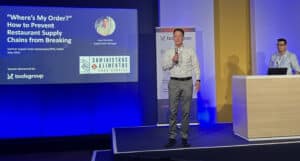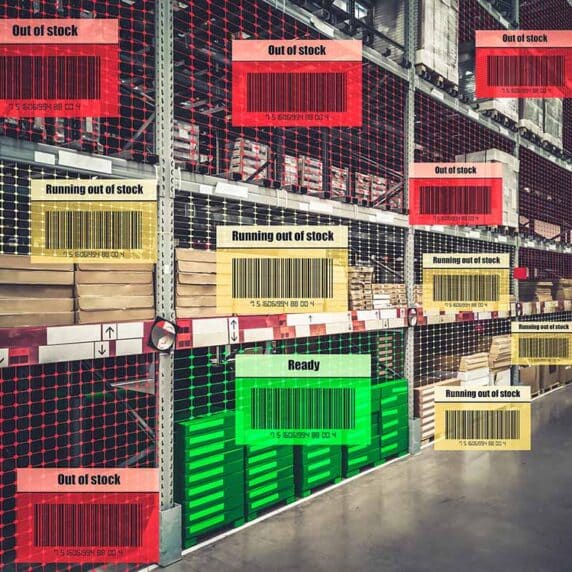Optimize Food Supply Chain with AI-Driven Planning
Meeting Demand Surges in the Restaurant Supply Chain
Peak demand days—such as National Hamburger Day or Super Bowl Sunday—create major stress on restaurant and foodservice logistics. To successfully optimize food supply chain operations during these surges, businesses must tightly manage ingredient availability, production schedules, and delivery timing-all within narrow, often unpredictable timeframes.
Promotions, seasonal events, and food-related holidays can significantly increase foot traffic and online orders, turning a popular item into a complex logistical challenge. Even global restaurant chains can suffer stockouts, delivery delays, or lost revenue if they lack visibility and control across their restaurant supply chain.
To maintain high performance under pressure, food logistics leaders need to adopt modern tools and strategies that enable proactive planning, real-time visibility, and agile execution. In today’s competitive landscape, AI-powered solutions are quickly becoming essential to optimize food supply chain performance and meet demand with precision.
Understanding the Food Supply Chain: From Farm to Table
A typical food supply chain for restaurants and foodservice providers includes several interconnected stages:
- Farms and Suppliers provide raw ingredients like lettuce, tomatoes, beef, and buns.
- Processors and Distributors transform these inputs (e.g., grinding beef into burger patties) and transport finished goods to restaurant hubs and restaurants.
- Restaurants prepare and serve meals across multiple formats: dine-in, drive-thru, delivery, and takeout.
During high-demand periods, seamless coordination among all these actors is vital to meeting customer expectations. Any breakdown-whether in production, transportation, or staffing-can ripple across the system, impacting product freshness, service quality, and brand loyalty.

Common Challenges in the Restaurant Supply Chain
Forecasting Demand Surges
On peak days, demand can spike dramatically-sometimes unpredictably. Inaccurate forecasts often result in overstocking, which leads to spoilage and waste, or understocking, which causes missed sales and customer dissatisfaction. Traditional forecasting methods often fail to capture real-world variables like local weather, special events, or marketing campaigns. This is where advanced demand forecasting tools powered by AI make a difference.
Managing Perishable Inventory
Inventory management becomes particularly complex due to the short shelf lives of ingredients, menu variability, and rapid shifts in consumer behavior. Restaurants can’t afford to run out of core ingredients-but holding excess inventory leads to waste. Real-time inventory visibility and inventory optimization tools help strike the right balance between availability and cost.
Logistics and Distribution Bottlenecks
On busy days, fulfillment teams face compressed delivery windows and higher order volumes. Transportation delays or distribution center bottlenecks can cascade into customer-facing issues. Optimizing food logistics processes like routing, scheduling, and warehouse management is critical to avoid disruption.
Labor Constraints and Staffing Shortfalls
Demand spikes require extra staffing for food prep, customer service, and logistics. Last-minute scheduling or misaligned staffing plans can lead to overtime costs or poor customer experience. AI-driven labor planning ensures an efficient workforce aligned with forecasted needs.
How to Optimize Food Supply Chain Operations
1. Plan Ahead with Data and AI Simulations
Proactive planning starts with leveraging historical sales data, event calendars, and external trends to build accurate forecasts. Simulation models allow teams to run “what-if” scenarios, testing their readiness for multiple demand patterns. This not only improves preparedness but also fosters confidence across teams and partners.
2. Strengthen Supplier Collaboration
To optimize food supply chain processes, upstream alignment is crucial. Close coordination with farms, processors, and distribution centers ensures that everyone is working from a shared plan. This makes it easier to adjust production schedules, avoid overbuying, and streamline logistics.
3. Use Real-Time Inventory Management
Digitally connected systems provide instant insights across warehouses, distribution hubs, and restaurants. By maintaining visibility into current stock and expected usage, businesses can reduce spoilage, lower inventory costs, and maintain high service levels.
4. Optimize Food Supply Chain and Delivery Routes
High-performance food logistics requires efficient transportation planning. Route optimization software can account for variables like traffic, distance, and delivery windows, enabling faster and more reliable fulfillment—even when order volume surges.
5. Enhance Labor Planning and Staff Readiness
AI-based labor optimization tools can generate predictive schedules based on forecasted demand, labor laws, and worker preferences. Training frontline teams in advance of busy periods helps boost morale, service quality, and speed of execution.

AI’s Role in Modern Food Logistics
Artificial intelligence is redefining how organizations optimize food supply chain planning and execution. Through machine learning and real-time analytics, AI can:
- Accurate, multi-variable demand forecasting, using historical trends, events, weather, and social media cues
- Inventory optimization and dynamic stock rebalancing across locations
- Automate replenishment decisions to avoid stockouts or overstocking
- Real-time monitoring and delivery tracking
- Optimize labor schedules and reduce manual planning time
By replacing reactive processes with predictive intelligence, AI empowers food businesses to stay ahead-no matter the challenge.
Case Study: Suministros & Alimentos Optimizes Food Supply Chain
Suministros & Alimentos, a leading food distribution company operating across Guatemala, El Salvador, Honduras, and Nicaragua, illustrates the benefits of AI-driven planning. Serving top restaurant brands like McDonald’s, they face fluctuating demand, short product lifecycles, and high customer expectations across four countries.
To address these challenges, they partnered with ToolsGroup and deployed AI-based demand forecasting and inventory optimization solutions.
Success Metrics with ToolsGroup
These results allowed the company to deliver fresher products, reduce environmental impact, and strengthen relationships across their restaurant supply chain.
Results in Action:
- Predicted demand at the SKU level across thousands of locations
- Reacted instantly to delivery disruptions using real-time tracking
- Minimized excess inventory and associated costs
- Improved supplier collaboration through accurate planning

Jose Chinchilla, Supply Planning Manager at Suministros & Alimentos, shared these achievements at the Gartner® Supply Chain Symposium/Xpo™ 2025 in Barcelona. His session, titled “Where’s My Order? How to Prevent Restaurant Supply Chains from Breaking,” highlighted how AI transforms food logistics and enables operational resilience.

The Path Forward: Optimize Food Supply Chain Decisions
As restaurant and food supply chain grow more complex, traditional approaches alone aren’t enough. Businesses that embrace AI-powered planning solutions are best positioned to:
- Predict demand accurately
- Reduce food waste and excess stock
- Respond rapidly to disruptions
- Maintain high service levels year-round
In short, those who optimize food supply chain operations using smart technologies gain a sustainable competitive advantage.
Elevate Food Supply Chain with AI-Powered Planning
Today’s food supply chains must be fast, flexible, and intelligent. With AI-enabled planning platforms, food distributors and restaurants can exceed expectations—even during their busiest days.
By harnessing machine learning and real-time data, industry leaders are transforming how they prepare, plan, and perform.





